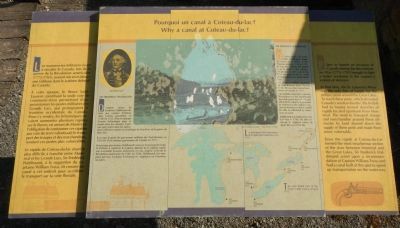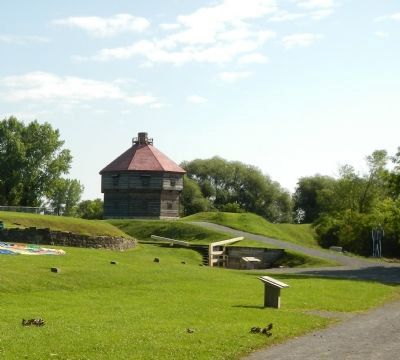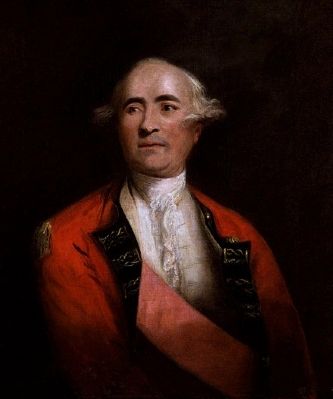Coteau-du-Lac in Vaudreuil-Soulanges, Québec — Central Canada (French-Canadian)
Why a canal at Coteau-du-Lac?
Pourquoi un canal à Coteau-du-lac?

Photographed By Barry Swackhamer, August 6, 2014
1. Why a canal at Coteau-du-Lac? Marker
Captions (English / French): The main British forts in the Great Lakes region around 1775. / Les principaux forts britanniques de la région des Grands lacs vers 1775. Picture of Sir Frederick Haldimand at top left.
Plans to launch an invasion of Canada during the Revolutionary War (1775-1783) brought to light a major weakness in the country’s system of defence.
At the time, the St. Lawrence River was the only line of supply for the military posts around the Great Lakes. To reach these posts, which defended Canada’s western border, the British as to bypass several stretches of rapids located upstream from Montréal. The need to transport troops and merchandise around these obstacles by land slowed down the supply of these posts and made them more vulnerable.
Since the rapids at Coteau-du-Lac formed the most treacherous section of the river between Montréal and the Great Lakes, Sir Frederick Haldimand acted upon a recommendation of Captain William Twiss and had a canal built at this spot to speed up transportation on the waterway.
Sir Frederick Halimand
Of Swiss origin, Sir Frederick Haldimand began his career as an officier in the Prussian army in 1740. In 1755 he was recruited by the British army to serve an active role in the military operations in North America during the Seven Years' War.
He acted as military governor of Trois-Rivières from 1763 to 1764. He was then named governor of Canada in 1777.
Up until the end of the American Revolution in 1783, Halimand devoted a great deal of time and effort in his capacity as governor to reinforcing the colony’s system of defence so that it would be able to withstand an American invasion.
Haldimand was replaced by Guy Carleton in 1786. He then returned to England where spent the rest of his life.
French:
Les manoeuvres militaires visant à envahir le Canada, lors de la guerre de la Revolution américaine (1775-1783), avaient mis en évidence une faiblesse dans le système défensif du Canada.
À cette époque, le fleuve Saint-Laurent constituait la seule voie de communication permettant d’approvisionner les postes militaires des Grand Lacs, qui protégeaient la frontière occidentale du Canada. Pour s’y rendre, les britanniques devaient surmonter plusieurs rapides sur le fleuve, en amont du Montréal; l’obligation de contourner ces rapids par voie de terre ralentissait le transport des troupes et des marchandise, rendant ces posters plus vulnérables.
Le rapide de Coteau-du-Lac étant la plus difficile à franchir entre Montréal et les Grands Lacs, Sir Frédérick Haldimand, à la suggestion du capitaine William Twiss, fit creuser un canal à cet endroit pour accélérer le transport sur la voie fluviale.
Sir Frederick Halimand
D’origine suisse, Sir Frederick Haldimand débuta une carrière d’officier dans l’armée prussienne en 1740. En
1755, il fut recruté par l’armée britannique pour se rendre dans les colonies. Il prit une part active dans les opérations militaires menées en Amérique du Nord lors de la guerre de Sept Ans.
Il occupa le poste de gouverneur militaire des Trois-Rivières en 1763-64. Il fut nommé gouverneur du Canada en 1777.
En tant que gouverneur, Haldimand consacra beaucoup de temps et d’effort à renforcer le système défensif de la colonie contre une éventuelle invasion américaine de cela, jusqu’à la fin de la Révolution américaine en 1783. En 1786, Haldimand fut remplacé par Guy Carleton. Il retourna en Angleterre où il termina ses jours.
Erected by Parks Canada / Parcs Canada.
Topics. This historical marker is listed in these topic lists: Forts and Castles • War of 1812 • War, US Revolutionary • Waterways & Vessels. A significant historical year for this entry is 1740.
Location. 45° 17.226′ N, 74° 10.574′ W. Marker is in Coteau-du-Lac, Québec, in Vaudreuil-Soulanges. Marker can be reached from Chemin du Fleuve close to Rue du Fort, on the left when traveling south. Touch for map. Marker is at or near this postal address: 307 Chemin du Fleuve, Coteau-du-Lac QC J0P 1B0, Canada. Touch for directions.
Other nearby markers. At least 8 other markers are within walking distance of this marker. The first lock canal in North America (here, next to this marker); The “rigolet” canal (a few steps from this marker); The construction of the canal (within shouting distance of this marker); The Coteau-du-Lac rapids (within shouting distance of this marker); Changes in the landscape (within shouting distance of this marker); A supply centre / Un poste de ravitaillement (within shouting distance of this marker); A canal excavated in the rock (within shouting distance of this marker); What is a lock canal? (within shouting distance of this marker). Touch for a list and map of all markers in Coteau-du-Lac.
More about this marker. This marker is located at Coteau-du-Lac National Historic Site.
Also see . . . Sir Frederick Halimand. Sir Frederick Haldimand, KB (August 11, 1718 – June 5, 1791) was a military officer best known for his service in the British Army in North America during the Seven Years' War and the American Revolutionary War. From 1778 to 1786, he served as Governor of the Province of Quebec, during which time he oversaw military operations against the northern frontiers in the war... His administration of Quebec was at times harsh, with the detention of numerous political dissidents and agitators. (Submitted on May 29, 2015, by Barry Swackhamer of Brentwood, California.)
Credits. This page was last revised on June 16, 2016. It was originally submitted on May 29, 2015, by Barry Swackhamer of Brentwood, California. This page has been viewed 365 times since then and 16 times this year. Photos: 1, 2, 3. submitted on May 29, 2015, by Barry Swackhamer of Brentwood, California. • Andrew Ruppenstein was the editor who published this page.

